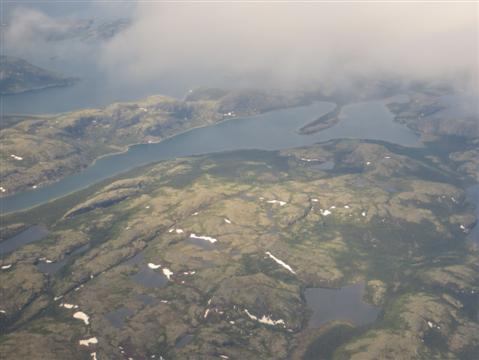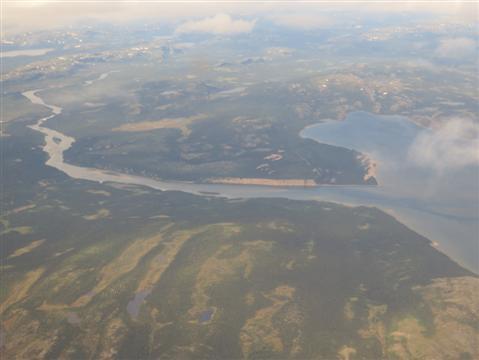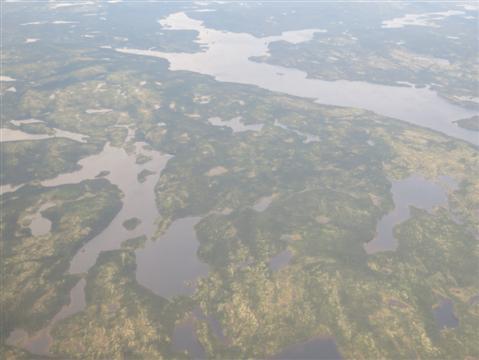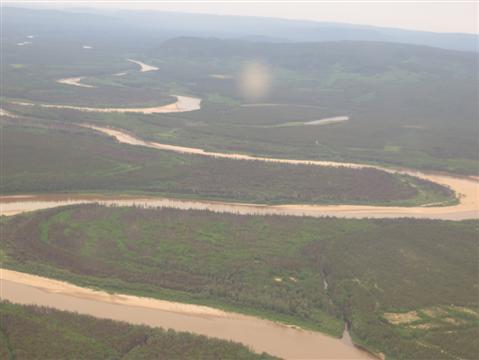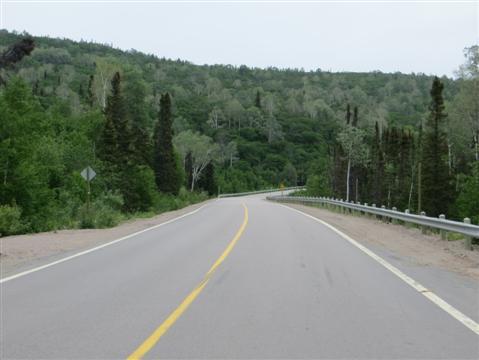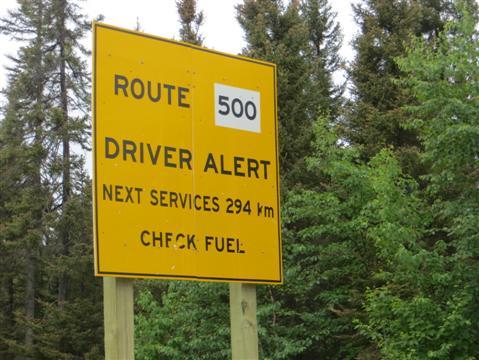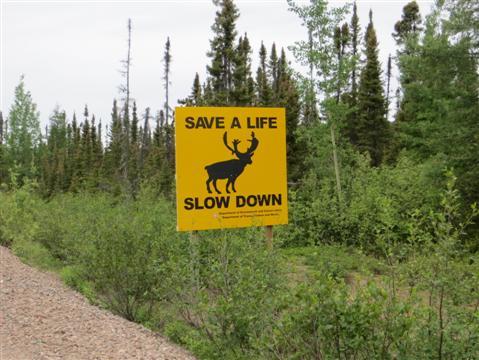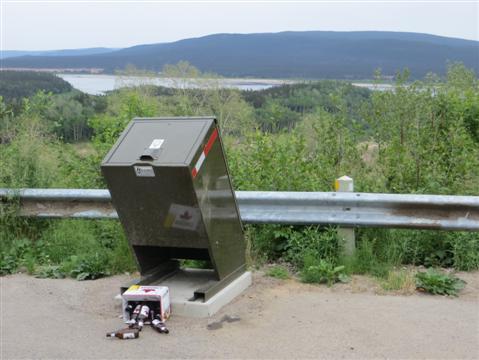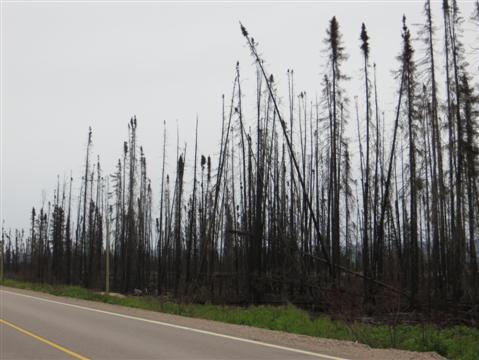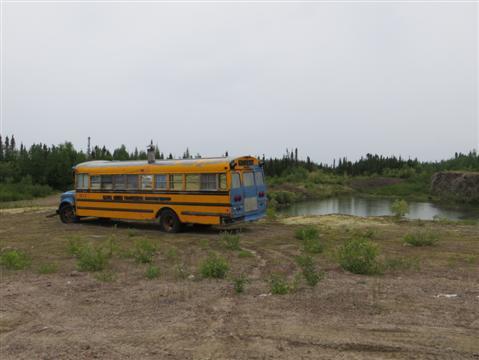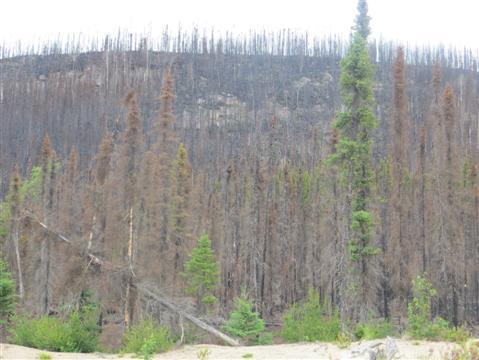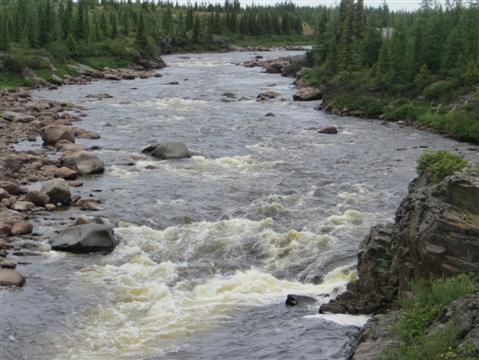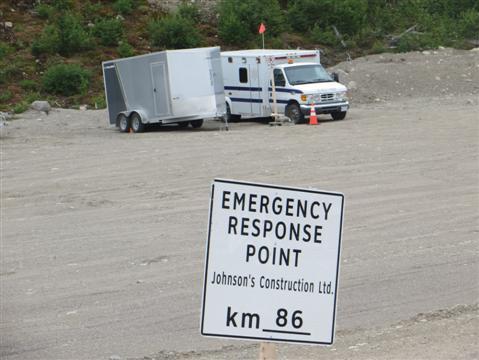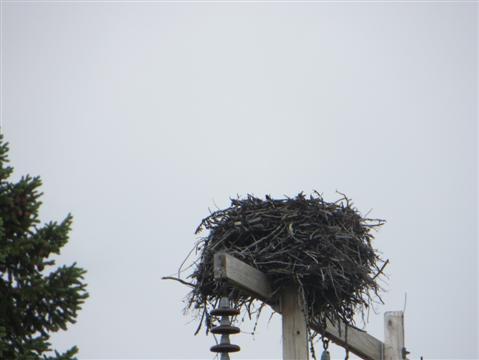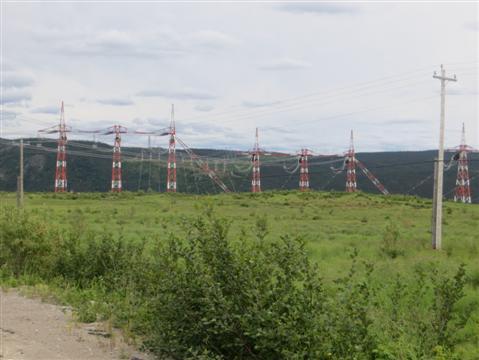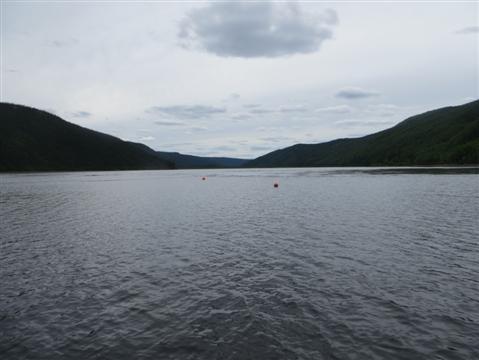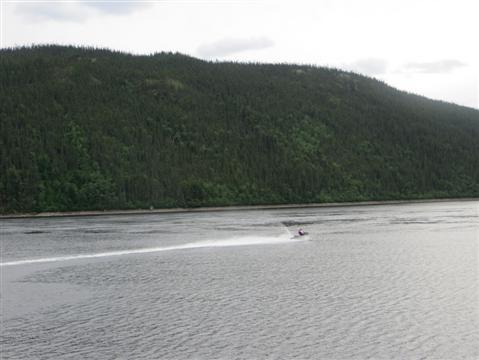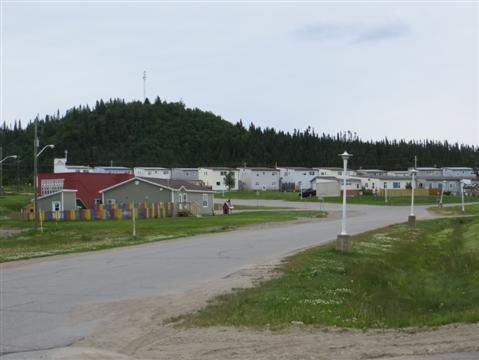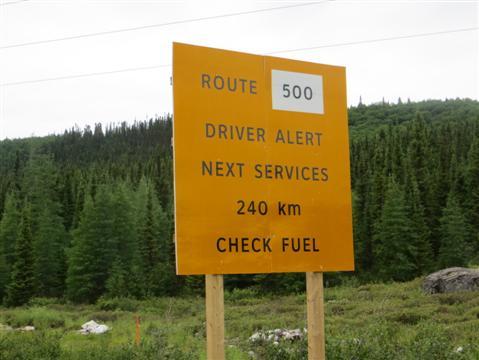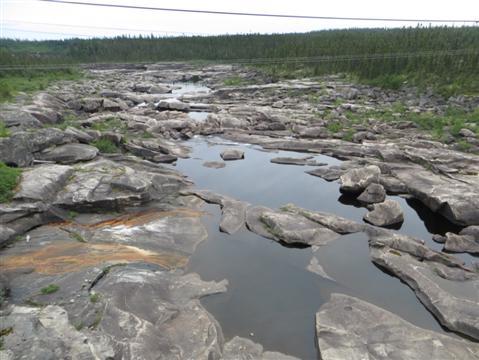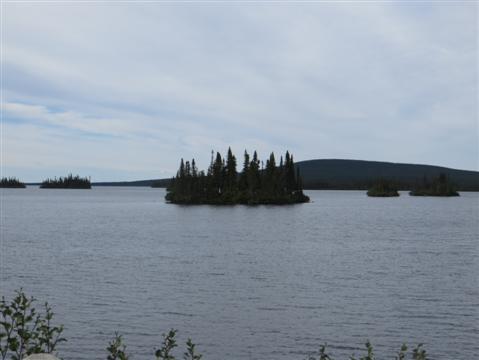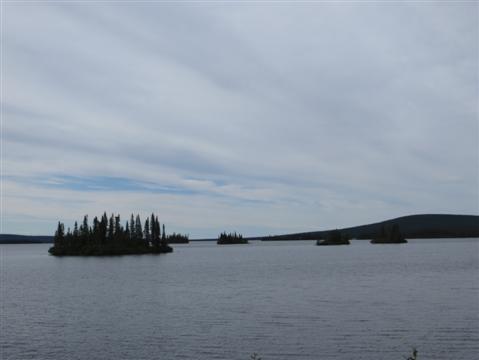The flight back to Goose Bay is aboard a DHC-6 of Innu Mikun, the other airline serving Labrador's north coast, created by the Innu people of Nitassinan (Our Land), their ancestral homeland in Labrador and Eastern Quebec.
The panorama is again spectacular, a sight-seer's and photographer's paradise: literally thousands of lakes and inlets trapped amid the green-dusted crags and ridges, from little ponds to vast sheets containing rugged fir-topped islands, sparkling blue and silver; bright white iced snow trapped in mountain folds; swirling veils of diaphanous clouds wafting over the peaks; the broad expanse of the Churchill River as we come into Goose Bay - a true symphony of water and land.
In-flight view
Another in-flight view
Since we were last in Goose Bay, the Royal Inn has been struck by lightning, and phone and Wifi links in the rooms are on the blink, so Yours Truly betakes himself to the still 'hot' hotspot in the reception area while Madam betakes herself to the bed for some energetic hours of serious TV surfing.
I return to the room, only to be curtly exiled once more to the reception area for some more Internet surfing as my idle chatter is disrupting Madam's concentration on the Canadian version of 'Undercover Boss,' which as far as I can discern revolves around the manager of Calgary Light Rail Transit and his inept efforts to haul floor-washing buckets up the stairs.
Another in-flight view
But I do manage to un-glue her from the TV, and the Canadian version of 'How I Became an Arsehole' or whatever else they're showing, to view another Labrador sunset - an incredible blaze of burned orange, red, crimson and purple streaking the wisps and fluffy bands of clouds overlaying a darkening deep blue sky. She is suitably wowed.
Another Labrador sunset
Another sunset view
On the morrow, it's the stairs of the Royal Inn that grab attention. A trail of splattered blood stains leads down them, across the parking lot, and right to the reception area, where breakfast is served and the stains stop. The receptionist denies any knowledge of a mob rub-out or any other likely cause for the blood-letting that I suggest, but she has no alternative to proffer.
Now this looks to be an interesting odyssey. Rentals don't let you take cars on the Trans-Labrador Highway for the 333 miles from Happy Valley-Goose Bay to the twin towns of Wabush and Labrador City, collectively known as Lab West - and even if they did there's no drop-off at the other end.
Churchill River from the air
So we're taking a private SUV taxi for an extortionate price that is, just let's say, $350 more than the air fare for both of us - and the driver, Paul, only has one leg. He notes my suppressed surprise as he gets out and reaches for his wheeled walker to go round and open the boot.
'Oh, don't worry about that,' quoths Paul, 'it doesn't affect my driving.' But I can't help thinking of Jonathan Safran Foer's book 'Everything Is Illuminated' in which the 'blind' old driver drives with a seeing-eye dog.
Trans-Labrador Highway
Paul, a mountain of a man, lost his left leg below the calf in a house renovation accident over 30 years ago and is not about to let that interfere with his work. As they say, one is better than none, automatic transmission obviates the problem, and Paul turns out to be a superb driver and guide - that is when I can make out what he is saying.
He speaks with an accent that oscillates between Somerset English and a Klingon stand-up comedy routine which Rivka finds easily intelligible - go figure.
Now the Trans-Labrador is nothing like the Trans-Amazon where I spent four days nearly 40 years ago enveloped in impenetrable clouds of red dust covering some 800 miles. The narrow two-lane Trans-Labrador is now paved all the way except for a 37-mile gravel section where contractors claim paving has been delayed by an act of God.
Another Trans-Labrador Highway view
We set off through forests of low firs and deciduous trees which, Paul says, put on an incredible show of glowing red, gold, brown, orange and yellow in autumn. Red signs nailed to roadside trees warn - in English, French, Inuktitut and Innu - of the dangers of contamination from PCBs and other toxic chemicals still polluting the water and ground from the U.S. and NATO use of Goose Bay air base.
Toxic warning sign
Huge sandbanks rise out of the Churchill River, its flow disrupted by the Muskrat Falls dam, 25 miles west of Goose Bay, part of the Lower Churchill Hydroelectric Project with a 3,074 megawatt capacity to export electricity to Canada's Maritime Provinces and the U.S.
A yellow signs warns: 'Route 500 Driver Alert Next Services 294 km (183 miles) Check Fuel.' A lot of people travel the highway with satellite phones supplied by the authorities for emergencies, but Paul feels they're no longer necessary given the paving of nearly the whole stretch.
You'd better fill up
Another yellow sign shows an antlered moose surrounded by the words: Save A Life Slow Down. A moose crosses the road in front of us: no antlers, a female. Rivka's very pleased, wild life in the wild at last, all her previous Bronx zoo claims notwithstanding. Then she returns to the wild life within the SUV - the remnants of the Royal Inn breakfast preserved in a Ziploc bag.
Watch the moose, now
The road undulates on through the hills. The occasional house or cabin stands out in a little clearing. At a lay-by a carton of empty beer bottles nestles at the bottom of a trash bin.
Anyone want a beer?
The fir trees are lower, patches of bright yellow-green lichen streak the granite rocks, puddles and ponds dot the marshy ground. Burned skeletons of trees mar both sides of the road, stark testimony to the many forest fires that Nature inflicts on the region.
Forest fires
A wide barren band slashes its way through the forests, stark testimony to the damage humans inflict on Nature, a pathway for the huge pylons that will replace the smaller version now carrying power lines.
Rape of the forest for power lines
An old yellow school bus, its front and back painted glaring blue, stands by the side of a pond, a chimney on its roof - an ersatz version of the cabin for those wanting to get away from it all. Paul says these are the cabin people - generally a married couple, no children - living along the Trans-Labrador either seasonally or all year long when snowmobiles replace SUV's in winter.
Bus 'cabin' with chimney
More conventional cabin
A great barren slash of charred trees on both sides shows where a three-week-long fire jumped the road last year. A single large cabin still stands, miraculously saved when the fire destroyed two others and the trees on either side of it. At Bob's Brook - all the streams along the way are called brooks - where there's a little waterfall and rapids, we cross a dirt track, the old road where it turns sharply left up a hill.
More fire
We reach the Pinus River. Careful how you pronounce that one, the 'I' is meant to be short as in pin.
Here in the boondocks vast hordes of nasty little black flies swarm together and hover around your face and any other exposed area, swooping in to bite, even getting through your hair to your scalp - as Yours Truly repeatedly finds out on his expeditions out of the SUV to take a photo. Road workers on the highway's gravel section are wearing special nets over their helmets and faces for protection.
The Trans-Labrador crosses many a river and stream
A couple of emergency response points have been set up along the way, a lay-by with an ambulance waiting to zip out in case of accidents or any other emergency.
Road worker vans pass with flashing orange lights. Ospreys have built their large nests atop power line pylons, and a couple of chicks push their heads out of one.
Emergency ambulance post
In parts the landscape is almost savannah-like. There are still the occasional cabins. The wounds of forest fires proliferate - as do the flies.
Osprey find home in the pylons
A panoply of huge red and white metal pylons soars up on the horizon, a plethora of cables swings across a deep mountain bowl surrounding a large lake, a forest of lower silver pylons crowds the right of the road, a digital red counter with the number 2358 fluctuates; now it's up to 2359, now down to 2358. We've reached Churchill Falls Generating Station - the half-way mark..
Churchill Falls power pylons
The counter moves up to 2370, the amount of megawatts the hydroelectric power station is producing at this nano-second. That's way less than half its maximum capacity of 5,428. It's taken us five hours to get here. Before the new road was paved it could take 12 hours.
Electricity output counter
Churchill Falls comprises a vast underground power station which, if you arrange it beforehand, you can go round on a three-hour tour. The machine hall, hacked out of solid granite some 1,000 feet underground, is as tall as a 15-storey building and as long as three football fields, with 11 generating units.
The reservoir created by the dikes covers 2,200 square miles, and is now a popular - relatively speaking given the scarcity of humans in the neighbourhood - boating and jet-skiing resort.
Churchill Falls lake
The falls plunged 245 feet over the cliffs before the dikes were built and the water diverted in 1970. Now they're barely a trickle, bursting into spate only during exceptional rains or spring thaws. Since long before Hamilton and Churchill came on the scene to bestow their names, the Innu called them Patses-che-wan - the narrow pass where the waters drop.
Down by the lakeside Rivka indulges in one of her favourite pastimes when travelling - collecting stones and boulders, tons of them. The last time she did this to me we were travelling through the Amazon.
Jet skiing on the reservoir
Churchill Falls town is a small compact affair with a semicircle of identical box-like houses, a population of some 650 mainly servicing the power station, a petrol garage, and one hotel, The Midway, which has a restaurant, where Madam and Yours Truly now repose, stuffing their faces.
Churchill Falls town
Better make sure you have enough petrol again
We cross the Churchill River, now a vast craggy bed with huge rocks, a trickle, tiny streams, minute falls and shadow rapids where a mighty torrent once flowed. The fir trees appear shorter again, stunted, skinny dwarfs, their needles protruding straight from the trunks like little ferns. With a land of hard granite with very little top soil and a winter of bitterest cold, it's a wonder there are any at all.
Churchill River after damming
Lake succeeds lake, many with domed wooded islands in their middle. The firs seem a little taller again. The cabins are more numerous and closer in between.
In the back of the SUV, Rivka nods off. A sudden whiff wafts forward, apprising me that she's woken up - the stale smell of ruddy potato crusted pan fried cod that she first picked at for dinner last night at Maxwell's in Goose Bay, and has been carting around ever since, for a moment just like this.
At last we arrive in Wabush, over nine hours after we started out, and I'm saying wow, what tremendous scenery, really worth it, and Madam's saying: 'Yes, really great scenery. Now let's go and eat, I'm hungry.'
______________
By the same author: Bussing The Amazon: On The Road With The Accidental Journalist, available with free excerpts on Kindle and in print version on Amazon.
And Swimming With Fidel: The Toils Of An Accidental Journalist, available on Kindle, with free excerpts here, and in print version on Amazon in the U.S here.
